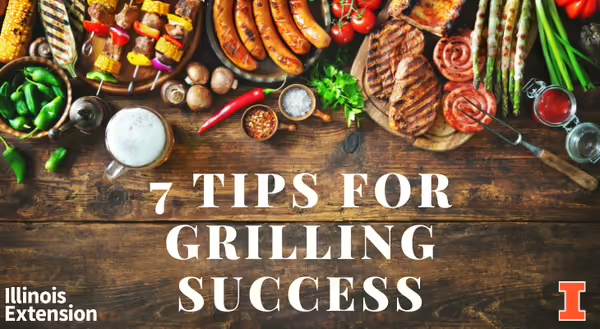
- A food thermometer is the best way to tell what internal temperature a food has reached. Different foods have different internal temperatures, so be aware.
- 145°F Beef, pork, lamb, veal (with a 3-minute rest) and fish
- 160°F Hamburgers and other ground meat
- 165°F Poultry and ground poultry
- Keep foods safe! Put leftovers – both grilled meats and side dishes - into the refrigerator within 2 hours of cooking, or 1 hour if the air temperature outside is above 90°F.
- A clean grill makes a big difference in the taste and quality of your grilled foods. Clean your grill before, during, and after grilling season.
- High-temperature cooking methods, such as grilling, frying, and roasting, can produce compounds that raise the risk of cancer, as seen in animal studies. These form in meat muscle, including beef, pork, fish, or poultry, when it is cooked using high-temperature methods. One way to reduce these compounds when grilling meat is to prevent charring.
- Remove visible fat. As fat heats up, it begins to melt. Fat that drops onto grill coals causes a flare-up, where the fat and coals create a short fire that comes back to the meat and burns or chars it.
- Precook meat in the microwave and immediately place it on the grill. Pre-cooking in the microwave first can release some of the juices that can drop on the coals.
- Use indirect heat to cook meat. This means move coals to one side of the grill and cook foods towards the other side. This helps prevent flare-ups and charred meat.
- Cut off charred parts of the meat.
- For juicy burgers- make from meat with 20-25% fat. This would be 75-80% lean on the packaging. Leaner ground meat will not be as juicy of a burger. Cook hot and fast, but don’t overcook. Some recommendations say to cook a ¾-inch burger on a 450°F grill for 8-10 minutes. Different grill types and outdoor environments may change this. Be patient with yourself while you learn how your grill works. This includes the tip to not press burgers with a spatula. For a juicy burger, the goal is not to push fats and water out of the burger and flip the burger only when it releases from the grill grates.
- Before cooking fish, grease grill grates or baskets. Fish and seafood do not have much fat and need oil to help prevent sticking. This is not as big of an issue if using planks or foil packs to cook fish. Fillets and shellfish do well over direct heat, while whole fish does better over indirect heat. Recommendations vary whether to start cooking a fillet skin side up or down. Practice to find out what works better for you. Fish is ready to be flipped when it releases itself from the grill grates. If it is not ready, try it again after 1 minute. In general, a 1-inch fillet of fish will cook in 8-10 minutes, being flipped halfway through.
- Most fruit can be grilled, but look for fruits that are firm and barely ripe. Firm fruits, like apples, pineapple, and pears maintain their shape and texture when grilled. Softer fruits, like peaches, mangoes, and nectarines, become mushy on the grill if overcooked. Some sources recommend grilling for only 5-8 minutes. Like other foods on the grill, let fruit cook long enough to release itself from the grill grates before flipping.
Keywords